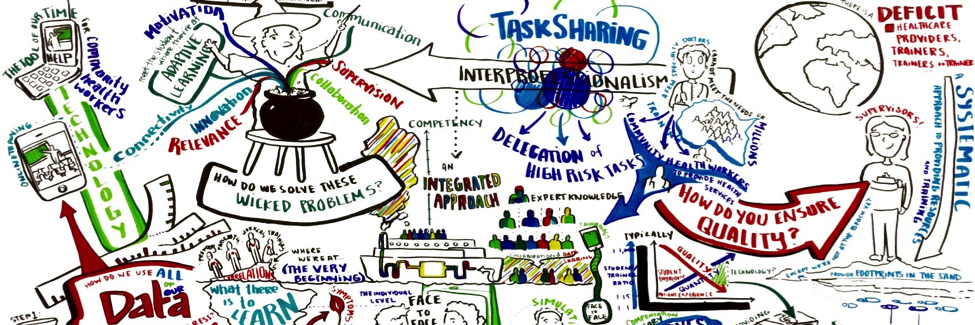
03 Feb HRH2030 Launches, Experts Weigh in on Human Resources for Health Solutions
Motivation. Quality. Efficiency. When you ask a group of health stakeholders about the most common stumbling blocks to effective human resources for health (HRH), this is what you hear. More than 50 people gathered February 2, 2016 to celebrate the kickoff of the HRH2030 program and engage with a panel of experts about these and related issues.
Funded by USAID and the U.S. President’s Emergency Plan for AIDS Relief (PEPFAR), HRH2030 strives to build the accessible, available, acceptable, and quality health workforce needed to end preventable child and maternal deaths (EPCMD), achieve an AIDS-Free Generation (AFG), protect communities from infectious diseases (PCID), achieve the Global Health Security Agenda (GHSA), and reach the goals of Family Planning 2020 (FP2020). In alignment with the World Health Organization’s Global Strategy on Human Resources for Health (HRH), HRH2030 aims to accelerate progress towards universal health coverage by building upon the successes of its predecessors.
HRH2030 Objectives:
- Improve performance and productivity of the health workforce
- Increase the number, skill mix, and competency of the health workforce
- Strengthen HRH/HSS leadership and governance capacity
- Increase sustainability of investment in HRH

Recognizing that a lack of resources represents a universal challenge to health systems, the HRH2030 kickoff event focused on the theme “Optimizing Existing Human Resources for Better Health Care.” Given the need to contain health expenditures, health systems must enable providers to be as productive and efficient as possible, deliver more health services with the same resources, perform up to standard, deliver quality health services, and support expanded access for more remote clients. The program will embrace this theme as it begins implementation—helping stakeholders do better with what they have now—while advocating for sustainable investments in HRH.
Reflecting the program’s efforts to draw on human resources experiences across sectors, a diverse panel fielded questions on state-of-the-art training models, increasing the use of HRH data analytics for decision-making, and innovative strategies for improving provider performance and productivity. The morning’s panelists included Amref Africa’s Peter Ngatia, Broadreach’s Colleen McLaughlin, Arizona State University (ASU) School of Nursing’s Teri Pipe, and Centers for Medicare and Medicaid Services’ (CMS) Hoangmai Pham.
Ngatia marveled over the gap between the number of health providers and the number of patients in many countries asking, “What do you do?” For Ngatia, technology for skills building and task-sharing—the process of delegation where tasks are moved, where appropriate, to less specialized health workers—offer tremendous and unrealized opportunities for optimizing utilization of the existing workforce.
Pipe and Ngatia addressed creative approaches to provider skills building, including leveraging technology. Amref Health Africa implements an e-learning program for nurses at more than 100 sites. ASU uses a combination of online and in-service training for its nursing students. ASU also provides for students a clinical simulation experience using high-risk scenarios. Using a mix of hands-on and virtual learning can overcome a lack of resources and physical space. Greater adoption of mobile technology to deliver training and professional support is the future, Ngatia said.
Better utilization of data is key for informing the best use of resources for ongoing provider skills-building or in-service training. More routine use of data is needed to impact worker performance and productivity by equipping HR managers with the evidence they need to advocate for staff and service delivery operation changes. McLaughlin explained that we are very good at using data for identifying service delivery areas needing improvement, but that we have had less of a focus on making concrete links to health systems barriers, including HRH. McLaughlin went on to explain how there is a need to better link HRH data to health data including population and disease burden. There are many opportunities for integration of key data sources into decision-making for health facility planning and operations, enabling facility managers to connect the dots—between HRH investment and health gains—for policymakers.
Data can also make the case for innovative strategies for improving health worker performance, productivity, and ultimately motivation. Hoangmai Pham from CMS highlighted lessons learned from the US domestic health experience in testing innovative service delivery models and utilizing data to drive financial efficiencies and improve service quality. Greater focus on coordinated care, teamwork, and consideration of client incentives and engagement were key strategies put forward for overcoming HRH constraints.
Following the panel discussion, USAID representatives and HRH2030 leadership shared their vision for the next five years. The work of HRH2030 will address many of the challenges discussed during the morning’s panel and will also support the Sustainable Development Goal of Universal Health Coverage and USAID’s Vision for Health Systems Strengthening (HSS).





